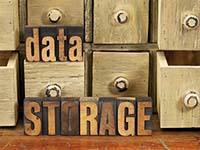Data Storage: The solution for your school

 ith so many data storage and digital document management options available, how do you make the right choice for your school.
ith so many data storage and digital document management options available, how do you make the right choice for your school.
Here we investigate some of the systems available, their strengths and their weaknesses.
Hard disk drives
The Hard disk drive (Hdd) stores all your data; word documents, photos, audio and video information and history in your computer.
A healthy Hdd ensures that data can be accessed quickly for display and transfer without corruption to your files. There are two main manufacturers, Western Digital and Seagate. Each year the capacity to store data increases, with 1 tb (terabyte) Hdds quite common now for external, laptop, and desktop computers. The storage capacity of a 1tb Hdd is quite amazing, 1 tb=1000 million kilo bytes or 1000 gb (equal to 250,000 songs) and for most people is more than adequate.
The bad news is that all Hdds will fail at sometime,
Newer Hdds can be more prone to failure than the older more stable drives. Hdds that over heated, are used with incorrect cables, computers suffering from blackouts/brownouts or incorrectly shutdown, malware, and viruses can create “bad sectors” on the hdd drive platter, which are segments of useless unreadable data that your computer tries to read.
Over time these bad sectors can accumulate (data cancer) which eventually slows down your Hdd and one day gives up , unfortunately with all your precious data on board.
Other issues to be aware of with any data storage devices are power spikes, being dropped or bumped, Hdd firmware issues, corrosion due to salt water, even the sulphides in Rotorua can cause damage, not to mention accidental and malicious deleted files, formatted Hdds and factory resets.
There are however cost effective solutions to recover data from corrupt, failed Hdds available.
Other Storage Options
Mirrored Drives (Raid 1)
These operate as 2 drives working in tandem, where should one drive fail then data is accessed from the other good working hdd, chances are statistically low for both drives to fail simultaneously. This is an excellent method of data storage, should one Hdd fail due to bad sectors, mechanical and/or electrical failure. However should the operator delete or shred files then the data is lost on both Hdds.
Solid State Drives (SSD)
These have no moving parts and work like a large USB flash drive. This technology appears to be the silver bullet, but there are issues to consider.
Some brands are poorly made and are vulnerable to screen freeze with a shelf life of approximately 3 years. Data can be lost due to power spikes/ failure, and like charging/discharging a battery will eventually slow down and fail as there is a limited amount of writes and rewrites to the SSD.
It is almost impossible to recover data from a failed SDD drive.
Cloud Storage
Cloud storage is also being touted as a safe alternative, and on the surface it is a great idea to use this method as a back-up for some of your files.
Digital Data Management
Larger schools should consider Digital document management.
Digital document management refers to a computer-based system that stores, tracks, and indexes your electronic and paper documents. Usually by logging in via a password your PC can access data from a central network server which processes requests and delivers data to your or other (client) computers , your individual password will determine what data you can access over a local network and internet for security purposes.
Paper documents are scanned and stored electronically. Digital document management keeps important digital files and documents,e.g. faxes, e-mails, photos even audio at your fingertips, eliminates walls of filing cabinets, minimises the need for paper, printer toners and inks and provides the utmost in information security.
Digital document management systems come in two categories: client-server systems and vendor-run applications.
Client-Server Systems
Client-server systems are housed in your school and stores data on your server in house or at another location.
The advantages are:
• You have total control of your data at all times.
• Software is easy to use
• Customizable and flexible (as your needs change, you can tweak the system )
• Regular backups to off-site computers are easy to schedule and inexpensive.
The disadvantages are:
• Upfront costs of software and additional servers
• Need IT staff/IT consultants to maintain and manage the system.
Vendor-Run Applications
Vendor-run applications, known as application service providers (ASP), reside on the service providers servers (cloud environment). Access to your data is through a web browser or a through client software.
The advantages are:
• Uninterruptible power supplies
• Reliable backups
• Upgraded features
• IT professional maintenance
• Multiple layers of security and firewalls
• Relatively low set up/ initial cost
The disadvantages are:
• Require active Internet connection which in NZ is still considered slow
• Web traffic may affect your document retrieval speed.
• Your ISP may have an outage
• Monthly usage payment depends on storage plans/data usage and can be subject to further costs
• Can still be hacked into, having files changed or deleted even with the best security available
• Depending on the provider you may lose 100% ownership or property rights on your data.
Take all of these factors into consideration before committing yourself to a system.
Often the time cost is more significant than the cost of the program so evaluate your needs carefully.









